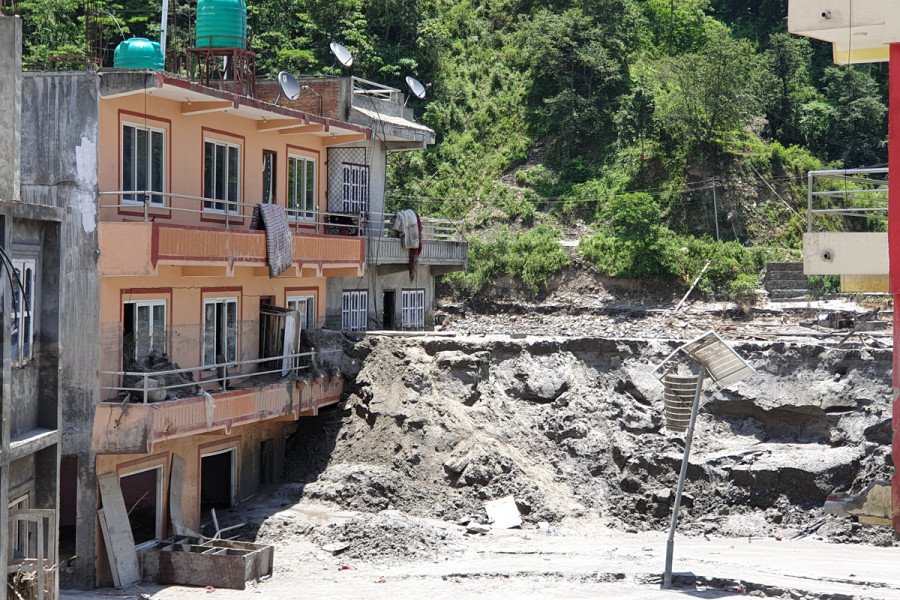Columns
Is climate change barging in?
Local governments have to come up with innovative, long-term solutions against climate events.
Madhukar Upadhya
This year’s monsoon began with the tragic events of Melamchi, where five people were killed, and many others are still unaccounted for. It left a flourishing town in ruins, with many buildings and farms along the river buried under dozens of feet of debris. A slurry of what looked like glacier flour continued to flow for days in the river. There were speculations as to how such an event could possibly have happened right at the beginning of the monsoon. The real cause hasn't been confirmed yet; what's certain is that a massive landslide, probably triggered by very high-intensity rain at upper elevations, blocked the river and the backed up water burst through the dam, releasing tremendous amounts of debris.
The beginning of monsoon is as welcome for our agro-based economy as it is a matter of concern because it causes widespread destruction, including loss of lives and property, every year. In recent years, some significant changes seem to have taken place, and continue to take place, in the rainfall pattern leading to increased levels of destruction.
Three days of continued rain resulted in simultaneous flooding across the Tarai, from Jhapa to Bardiya, in 2017. It happened because the cloud was stuck over the Tarai for three days and was unable to move northward to the mountains. Consequently, the Kulekhani reservoir, situated across the Mahabharat hills barely 30 kilometres north of the southern plains as the crow flies, didn't get replenished that year. The years 2018 and 2019 saw unexpected droughts in the middle of the monsoon in the hills of eastern Nepal as the winds failed to bring adequate rain. The provincial government had to provide monetary support to farmers whose staple summer crops failed those years.
The year 2020 experienced both extremes. More than 400 landslides events, several of them quite deadly in the middle mountain regions, killed over 300 people and damaged infrastructure across a wide area. They were caused by high intensity localised rainfall events that occurred one after the other, triggering damaging debris flow in the least expected areas, from Sankhuwasabha in the east to Bajura in the west. This was followed by a dry winter which culminated in widespread forest fires through parts of the country, destroying vast swaths of forests. The Melamchi event is the latest in a series of such unprecedented occurrences. High-intensity rain at a higher elevation, a possible result of a warming atmosphere, caused massive landslides and floods in the upper areas of the basin where human interference is minimal. Four weeks later, a similar cloud burst occurred in Himachal Pradesh, India.
Common element
A common element among these events is perhaps a change in cloud movement. In 2017, the cloud was trapped over Tarai for three days, whereas in 2020, it was mostly concentrated in isolated areas in the middle hills. In 2021, it moved to the high mountains. If the events of these past five years are any indication of the extreme events likely to occur due to climate change, it seems climate change is already barging in rather than knocking on the door gently.
The distribution of monsoon rainfall in our region is greatly influenced by a number of systems, such as the presence of the Westerly winds, the northeastern monsoon, as well as the complex topography of the Himalayas. It appears that the rapid and monotonic warming of the Indian Ocean has influenced these systems significantly. Though expected to bring above average rain, this year's monsoon remained weak for nearly a month because the cross-equatorial wind was weak. Thus, in the early days, while western Nepal waited for rain to arrive, the monsoon dumped all its moisture in the central parts because the Westerly wind was still active. In sum, changes in weather pattern are progressively becoming unpredictable.
Though some progress has been made in reducing flood risks in the plains and valleys through early warning, our capacity to reduce water-induced disaster risks in the hills remains weak. We build makeshift shelters for those rendered homeless and make diversions or temporary bridges when roadways are damaged to keep vehicles moving. Unlike the reconstruction of earthquake-damaged structures, which has had the gift of time for planning and execution, there is a window of barely eight months between two monsoons for the reconstruction of damaged structures. Before plans are even in place to replace makeshift structures, the next monsoon arrives to cause damage in new areas. No wonder the macabre mosaic of damaged houses, bridges, roads, and farms of the past can be seen strewn across the country. Damaged farmlands of poor farmers are rarely reclaimed. Hence, the unfolding weather events demand serious attention, as high-intensity rain has become more frequent.
Linkages
Until we begin to link monsoon damage with agriculture and overall economic growth and make that a key concern in development plans, which we haven’t done yet, we will never be able to address this emerging challenge. Because we've failed to see the direct linkages, our plans still follow a traditional path. Unfortunately, even under the federal system, provinces and local governments, tasked with addressing people’s local concerns including water-induced disasters which pose a major hurdle to their prosperity, have failed to see these linkages.
The provincial government that provided monetary support to farmers when crops failed due to drought didn't acknowledge this problem in their annual plans in the following years. The tone of the plan is no more than a replica of central plans, which derail the issues with boutique programmes. The ‘one village, one pond’ programme started by Province 1 to address droughts in areas where springs dried up decades ago is a glaring example. Moreover, the province continued with lifting, pumping, and drilling bore wells for water in these areas. These steps may be necessary to appease immediate needs but do nothing in the long term to fix the actual problem that the events of the past five years have highlighted.
Understanding the shift, predicting changing trends of monsoon, and establishing the linkages with our economy is central to our future well-being. For this, first, we need to realise that local weather changes from one basin to another and from valley to ridge within an incredibly short distance due to our unique and unusual topography. And suppose climate change really is barging in. In that case, we must strive to make basin-wise weather forecasts by collecting real-time data on rainfall, including at high altitudes—something we currently lack—if we are to make any sense of these damaging and changing patterns in order to enable us to deal with the consequences more effectively.




 5.44°C Kathmandu
5.44°C Kathmandu















